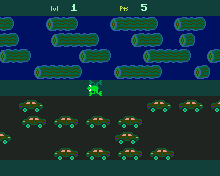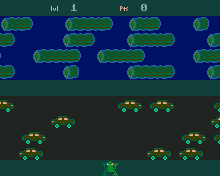- Make 10 games for Pine-2K: Achievement unlocked!!!
I guess I’m the first one to reach 10 games made for Pine-2K… so congrats! to myself.


sb-frog by SkyBerron.zip (156.8 KB)
I guess I’m the first one to reach 10 games made for Pine-2K… so congrats! to myself.


sb-frog by SkyBerron.zip (156.8 KB)
Congrats!! My wife will be happy to see this. Her favourite gamenis Frogger! 
You are just crushing it 
If she’s used to your high quality graphics, please tell her I’m sorry, I can’t do better pixel art. 
For a pine2k game its still good. You can always ask if you need a hand in the future 
I love frogger - thanks 
This is a classic! It was one of my favorites in Vic-20 
Btw. Still making my first entry for P2K…
A question, as you have made so many games for P2K: what would you change in Pine2K?
Hmmm… difficult to answer your question is. Fixing the remaining bugs should be a priority, indeed. I find debugging a bit difficult, mainly due to crashes in large functions, bugs that disappear changing execution order, out of range errors, bool var assignment bugs and some trivial coding errors that can be difficult to catch: missing local var declarations, globals clashing local vars, …
Setting up a detailed tilemap can take some valuable progmem and 16x16 tiles are a bit ackward to use, in part due to tileshift() limitations. I still haven’t been able to use custom 16x16 tiles. For simplicity, I end up using tilemaps made up with solid colors.
I miss some math functions (sqrt, abs, sgn).
Sprite recolouring is pure trial&error for me, so I try to avoid that. I feel the palette, although 256 in size, is not a well balanced one.
But, overall, the language feels very well balanced, partly because I used to code in BASIC and afterwards plain C and afterwards KC and afterwards JS and afterwards Lua.
I need to code some more games to have a more qualified opinion. 
Sounds nothing too critical (at least if the crashing bugs are not too frequent). That is promising! I was expecting more comparison between Pico-8 and Pine-2K. Seems like @FManga has been able to include the most essential features to P2K already  Excellent work given the time P2K has been in the “market” comparing to the competitors.
Excellent work given the time P2K has been in the “market” comparing to the competitors.
That’s another story. To be fair, I think you can’t compare them as they are much different. Pico-8 implements nearly full featured Lua, so you can even use OOP through metatables, and coroutines if you wish to. Pico-8 uses internally 16.16 fixed math but hides integer math from the user. Most common used math functions are implemented. The constraints are very different: screen is 128x128 16 color with framebuffer you can read/write directly to. You have a token limit in Pico-8 but it’s more than enough to deploy a full game. Every Pico-8 cart is a single file that includes Lua code, a spritesheet, a tilemap, sfx and tracker music. Sprites and tiles come from a 128x64 spritesheet that can be expanded to 128x128 if you sacrifice half the tilemap. The tilemap drawing function map() allows very flexible use of the tilemap. Sprite drawing operations allow scaling, streching and now even rotating and shearing. Pico-8 VM allows you to use up to 2 Mb of dynamic memory, including memory needed for the runtime: stack, heap, …
If you compare Pine-2K to tweet tweet carts for Pico-8, then Pine-2K wins as you can pack much more content in 2K of compiled code, as assets and const arrays do not count, than in 560 characters of code with no assets.
@FManga’s java implementation also has floats which are internally implemented as fixed point integers, which was really nice. I hope it finds its way to P2K also 
Shameless reminder that I wrote the library that implements the fixed points. :P
It requires a minor bit of tweaking to work on Pokitto but it will work so you can have easy-to-use fixed points in C++.